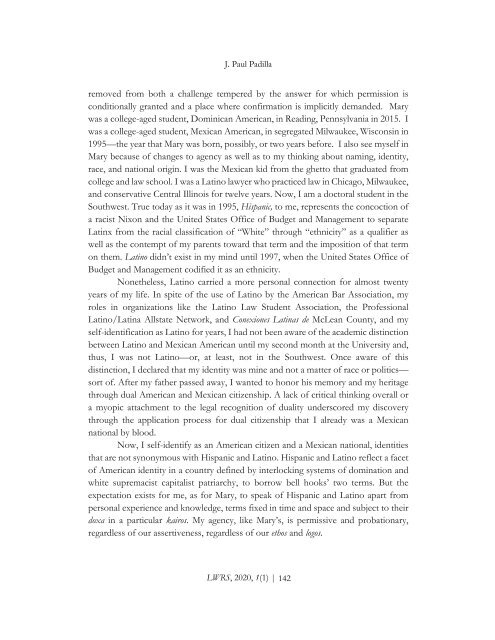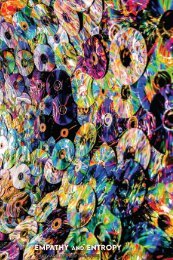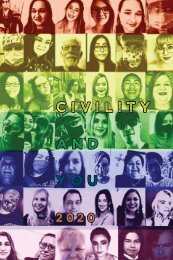LWRS June 2020 Volume 1, Issue 1
Inaugural Issue co-edited by Yndalecio Isaac Hinojosa and Isabel Baca
Inaugural Issue co-edited by Yndalecio Isaac Hinojosa and Isabel Baca
Create successful ePaper yourself
Turn your PDF publications into a flip-book with our unique Google optimized e-Paper software.
J. Paul Padilla<br />
removed from both a challenge tempered by the answer for which permission is<br />
conditionally granted and a place where confirmation is implicitly demanded. Mary<br />
was a college-aged student, Dominican American, in Reading, Pennsylvania in 2015. I<br />
was a college-aged student, Mexican American, in segregated Milwaukee, Wisconsin in<br />
1995—the year that Mary was born, possibly, or two years before. I also see myself in<br />
Mary because of changes to agency as well as to my thinking about naming, identity,<br />
race, and national origin. I was the Mexican kid from the ghetto that graduated from<br />
college and law school. I was a Latino lawyer who practiced law in Chicago, Milwaukee,<br />
and conservative Central Illinois for twelve years. Now, I am a doctoral student in the<br />
Southwest. True today as it was in 1995, Hispanic, to me, represents the concoction of<br />
a racist Nixon and the United States Office of Budget and Management to separate<br />
Latinx from the racial classification of “White” through “ethnicity” as a qualifier as<br />
well as the contempt of my parents toward that term and the imposition of that term<br />
on them. Latino didn’t exist in my mind until 1997, when the United States Office of<br />
Budget and Management codified it as an ethnicity.<br />
Nonetheless, Latino carried a more personal connection for almost twenty<br />
years of my life. In spite of the use of Latino by the American Bar Association, my<br />
roles in organizations like the Latino Law Student Association, the Professional<br />
Latino/Latina Allstate Network, and Conexiones Latinas de McLean County, and my<br />
self-identification as Latino for years, I had not been aware of the academic distinction<br />
between Latino and Mexican American until my second month at the University and,<br />
thus, I was not Latino—or, at least, not in the Southwest. Once aware of this<br />
distinction, I declared that my identity was mine and not a matter of race or politics—<br />
sort of. After my father passed away, I wanted to honor his memory and my heritage<br />
through dual American and Mexican citizenship. A lack of critical thinking overall or<br />
a myopic attachment to the legal recognition of duality underscored my discovery<br />
through the application process for dual citizenship that I already was a Mexican<br />
national by blood.<br />
Now, I self-identify as an American citizen and a Mexican national, identities<br />
that are not synonymous with Hispanic and Latino. Hispanic and Latino reflect a facet<br />
of American identity in a country defined by interlocking systems of domination and<br />
white supremacist capitalist patriarchy, to borrow bell hooks’ two terms. But the<br />
expectation exists for me, as for Mary, to speak of Hispanic and Latino apart from<br />
personal experience and knowledge, terms fixed in time and space and subject to their<br />
doxa in a particular kairos. My agency, like Mary’s, is permissive and probationary,<br />
regardless of our assertiveness, regardless of our ethos and logos.<br />
<strong>LWRS</strong>, <strong>2020</strong>, 1(1) | 142





